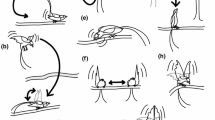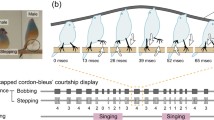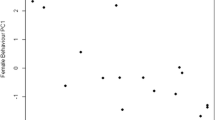Abstract
Birds are well known for displaying courtship exhibitions shaped by sexual selection that involve combinations of visual, motor, and acoustic components. Among such multifaceted exhibitions are those of male piprids, which can perform coordinated or cooperative displays to attract females. Here we focus on the Swallow-tailed Manakin (Chiroxiphia caudata), endemic to the Atlantic Forest, whose displays include two or more males executing a cartwheel-type movement (“cooperative display”) and solo exhibitions. We used videography to describe and analyze male maneuvers and to test differences in display parameters between courts (where adult males perform coordinated/cooperative displays in groups of two to six individuals within an arena) and between dominant and subordinate males. We recorded displays of individuals from four courts in southern Brazil during two breeding seasons. We identified nine male display elements, five in cooperative, three in solo formations and one in other contexts, in addition to two elements performed exclusively by females. Sequences of male display elements were highly stereotyped, but three display parameters differed between courts: vertical flight height, distance from which males approached females and cartwheel velocity. Moreover, subordinates flew longer vertical flights than dominants. This variability suggests that females may evaluate courts based on display parameters, leading to their decision to remain at the perch, attend the solo display and eventually copulate. The vertical flight duration can also be a signal used during intrasexual communication, such as for hierarchy establishment. Our detailed description of male display attributes provides essential evidence that courts differ in motor parameters, and opens an avenue for further studies on sexual selection mechanisms in the Swallow-tailed Manakin and other manakins.
Zusammenfassung
Variation visueller Komponenten der Schaubalz beim Blaubrustpipra ( Chiroxiphia caudata ) innerhalb und zwischen Balzarenen.
Vögel sind bekannt für ihr auffälliges, durch sexuelle Selektion geformtes Balzverhalten, welches Kombinationen aus visuellen, motorischen und akustischen Komponenten umfasst. Zu diesen facettenreichen Darbietungen gehören die der männlichen Schnurrvögel, welche zur Anlockung von Weibchen koordiniertes oder kooperatives Schaubalzverhalten ausführen können. Hier betrachten wir den für den Atlantischen Regenwald endemischen Blaubrustpipra (Chiroxiphia caudata), bei dem als Teil der Schaubalz zwei oder mehr Männchen einen radschlagähnlichen Bewegungsablauf („kooperative Schaubalz“) sowie Einzeldarbietungen zeigen. Mittels Videoaufnahmen beschrieben und analysierten wir die Manöver der Männchen und untersuchten diese auf Unterschiede bezüglich der Parameter des Balzverhaltens zwischen verschiedenen Balzarenen sowie zwischen dominanten und untergeordneten Männchen. Über zwei Brutsaisons hinweg nahmen wir Schaubalzen von Individuen aus vier Balzarenen in Südbrasilien auf. Wir identifizierten neun Schaubalzelemente bei den Männchen, fünf davon in kooperativen, drei in einzelnen Darbietungen sowie eine weitere in anderem Kontext auftretende; zusätzlich noch zwei Elemente, die ausschließlich von den Weibchen ausgeführt wurden. Die Abfolge der Schaubalzelemente war bei den Männchen hochgradig stereotyp, drei Parameter unterschieden sich jedoch zwischen den Balzarenen: vertikale Flughöhe, der Abstand, bis zu dem die Männchen sich den Weibchen näherten, und die Geschwindigkeit des Radschlags. Außerdem führten untergeordnete Vögel längere vertikale Flüge aus als dominante. Diese Variabilität legt nahe, dass die Weibchen die Arenen möglicherweise aufgrund der Darbietungsparameter bewerten, woraufhin sie entscheiden, ob sie auf der Sitzwarte bleiben, der Einzelvorstellung zuschauen und schließlich kopulieren. Die Dauer des Vertikalfluges kann auch ein Signal im Rahmen der intrasexuellen Kommunikation darstellen und zum Beispiel der Hierarchiefindung dienen. Unsere detaillierte Beschreibung der Attribute des männlichen Balzverhaltens liefert entscheidende Belege dafür, dass sich die Arenen hinsichtlich der motorischen Parameter unterscheiden und bereitet den Weg für weiterführende Untersuchungen zu den Mechanismen der sexuellen Selektion beim Blaubrustpipra und anderen Schnurrvögeln.




Similar content being viewed by others
References
Andersson M (1994) Sexual selection. Princeton University Press, NJ
Barske J, Schlinger BA, Wikelski M, Fusani L (2011) Female choice for male motor skills. Proc R Soc B Biol Sci 278:3523–3528
Bates D, Maechler M, Bolker B, Walker S (2015) Fitting Linear Mixed-Effects Models Using lme4. J Stat Softw 67:1–48
Bodony D, Day L, Friscia A, Fusani L, Kharon A, Swenson G, Wikelski M, Schlinger B (2016) Determination of the wingsnap sonation mechanism of the Golden-collared Manakin (Manacus vitellinus). J Exp Biol 219:1524–1534
Boscolo D, Metzger JP (2009) Is bird incidence in Atlantic forest fragments influenced by landscape patterns at multiple scales? Landscape Ecol 24:907–918
Bostwick KS, Prum RO (2005) Courting bird sings with stridulating wing feathers. Science 309:736
Brodt MSC, Della-Flora F, Cáceres N (2013) Non-linear ascension in a reproductive hierarchy of the Blue Manakin (Chiroxiphia caudata). Acta Ethol 17:181–185
Byers J, Hebets E, Podos J (2010) Female mate choice based upon male motor performance. Anim Behav 79:771–778
Cárdenas-Posada G, Cadena CD, Blake JG, Loiselle BA (2018) Display behaviour, social organization and vocal repertoire of Blue-backed Manakin Chiroxiphia pareola napensis in northwest Amazonia. Ibis 160:269–282
Coccon F, Schlinger BA, Fusani L (2012) Male Golden-collared Manakins Manacus vitellinus do not adapt their courtship display to spatial alteration of their court. Ibis 154:173–176
Cotton S, Small J, Pomiankowski A (2006) Sexual selection and condition-dependent mate preferences. Curr Biol 16:R755–R765
Darwin C (1871) The descent of man, and selection in relation to sex. Murray, London
DuVal EH (2007a) Cooperative display and lekking behavior of the Lance-tailed Manakin (Chiroxiphia lanceolata). Auk 124:1168–1185
DuVal EH (2007b) Social organization and variation in cooperative alliances among male Lance-tailed Manakins. Anim Behav 73:391–401
Foster MS (1977) Odd couples in manakins: a study of social organization and cooperative breeding in Chiroxiphia linearis. Am Nat 11:845–853
Foster MS (1981) Cooperative behavior and social organization of the Swallow-tailed Manakin (Chiroxiphia caudata). Behav Ecol Sociobiol 9:167–177
Foster MS (1987) Delayed maturation, neoteny, and social system differences in two manakins of the genus Chiroxiphia. Evolution 41:547–558
Francisco MR, Gibbs HL, Galetti PM, Lunardi VO, Galetti Junior PM (2007) Genetic structure in a tropical lek-breeding bird, the Blue Manakin (Chiroxiphia caudata) in the Brazilian Atlantic Forest. Mol Ecol 16:4908–4918
Francisco MR, Gibbs HL, Galetti PM Jr (2009) Patterns of individual relatedness at Blue Manakin (Chiroxiphia caudata) leks. Auk 126:47–53
Fusani L, Schlinger BA (2012) Proximate and ultimate causes of male courtship behavior in Golden-collared Manakins. J Ornithol 153:119–124
Fusani L, Giordano M, Day LB, Schlinger BA (2007) High-speed video analysis reveals individual variability in the courtship displays of male Golden-collared Manakins. Ethology 113:964–972
Girard MB, Kasumovic MM, Elias DO (2011) Multi-modal courtship in the Peacock Spider, Maratus volans (OP-Cambridge, 1874). PLoS One 6:e25390
Gomez D, Richardson C, Lengagne T, Plenet S, Joly P, Léna JP, Théry M (2009) The role of nocturnal vision in mate choice: females prefer conspicuous males in the European Tree Frog (Hyla arborea). Proc R Soc B Biol Sci 276:2351–2358
Hasui E, Gomes VSM, Kiefer MC, Tamashiro J, Silva WR (2009) Spatial and seasonal variation in niche partitioning between Blue Manakin (Chiroxiphia caudata) and Greenish Schiffornis (Schiffornis virescens) in southeastern Brazil. Stud Neotrop Fauna Environ 44:149–159
Hothorn T, Bretz F, Westfall P (2008) Simultaneous inference in general parametric models. Biom J 50:346–363
Keyser AJ, Hill GE (2010) Structurally based plumage coloration is an honest signal of quality in male Blue Grosbeaks. Behav Ecol 11:202–209
LeBas NR, Marshall NJ (2000) The role of colour in signalling and male choice in the agamid lizard Ctenophorus ornatus. Proc R Soc B Biol Sci 267:445–452
Lill A (1974) Sexual behavior of the lek-forming White-bearded Manakin (Manacus manacus trinitalis Hartert). Z Tierpsychol 36:1–36
Lindsay WR, Houck JT, Giuliano CE, Day LB (2015) Acrobatic courtship display coevolves with brain size in manakins (Pipridae). Brain Behav Evol 85:29–36
Loiselle BA, Graham CH, Goerck JM, Ribeiro MC (2010) Assessing the impact of deforestation and climate change on the range size and environmental niche of bird species in the Atlantic forests, Brazil. J Biogeogr 37:1288–1301
Lukianchuk KC, Doucet SM (2014a) Cooperative courtship display in Long-tailed Manakins Chiroxiphia linearis: predictors of courtship success revealed through full characterization of display. J Ornithol 155:729–743
Lukianchuk KC, Doucet SM (2014b) A young manakin knows his place: evidence for an age-graded dominance hierarchy among Long-tailed Manakins. Ethology 120:693–701
Mallet-Rodrigues F, Dutra R (2012) Acquisition of definitive adult plumage in male Blue Manakins Chiroxiphia caudata. Cotinga 34:24–27
Manica LT, Graves JA, Podos J, Macedo RH (2016) Multimodal flight display of a Neotropical songbird predicts social pairing but not extrapair mating success. Behav Ecol Sociobiol 70:2039–2052
Manica LT, Macedo RH, Graves JA, Podos J (2017) Vigor and skill in the acrobatic mating displays of a Neotropical songbird. Behav Ecol 28:164–173
Marques Silva S, Eduardo Agne C, Aleixo A, Bonatto SL (2018) Phylogeny and systematics of Chiroxiphia and Antilophia manakins (Aves, Pipridae). Mol Phylogenet Evol 127:706–711
Møller AP, Birkhead TR (1994) The evolution of plumage brightness in birds is related to extrapair paternity. Evolution 48:1089–1100
Nowicki S, Peters S, Podos J (1998) Song learning, early nutrition and sexual selection in songbirds. Am Zool 38:179–190
Ota N, Gahr M, Soma M (2015) Tap dancing birds: the multimodal mutual courtship display of males and females in a socially monogamous songbird. Sci Rep 5:16614
Patricelli GL, Uy JAC, Walsh G, Borgia G (2002) Sexual selection: male displays adjusted to female’s response. Nature 415:279–280
Prum RO (1994) Phylogenetic analysis of the evolution of alternative social behavior in the manakins (Aves: Pipridae). Evolution 48:1657–1675
Prum RO (1997) Phylogenetic tests of alternative intersexual selection mechanisms: trait macroevolution in a polygynous clade (Aves: Pipridae). Am Nat 149:668–692
Prum RO (1998) Sexual selection and the evolution of mechanical sound production in manakins (Aves: Pipridae). Anim Behav 55:977–994
R Core Team (2015) R: a language and environment for statistical computing. R foundation for statistical computing. Vienna, Austria. http://www.R-project.org
Reginato M, Goldenberg R (2007) Análise florística, estrutural e fitogeográfica da vegetação em região de transição entre as Florestas Ombrófilas Mista e Densa Montana, Piraquara, Paraná, Brasil. Hoehnea 34:349–364
Rueden CT et al (2017) ImageJ2: ImageJ for the next generation of scientific image data. BMC Bioinform 18:529
Ryder TB, Durães R (2005) It’s not easy being green: using molt and morphological criteria to age and sex green-plumage manakins (Aves: Pipridae). Ornithol Neotrop 16:481–491
Scholes E (2006) Courtship ethology of Carola’s Parotia (Parotia carolae). Auk 123:967–990
Scholes E (2008) Structure and composition of the courtship phenotype in the bird of paradise Parotia lawesii (Aves: Paradisaeidae). Zoology 111:260–278
Schaedler M, Ribeiro PHL, Guaraldo AC, Manica LT (2019) Acoustic signals and repertoire complexity in Swallow-tailed Manakins (Chiroxiphia caudata, Aves: Pipridae). Bioacoustics. https://doi.org/10.1080/09524622.2018.1563870
Scholes E, Gillis JM, Laman TG (2017) Visual and acoustic components of courtship in the bird-of-paradise genus Astrapia (Aves: Paradisaeidae). PeerJ 5:e3987
Sick H (2001) Ornitologia Brasileira. Nova Fronteira, Rio de Janeiro
Snow DW (1963) The display of the Blue-backed Manakin, Chiroxiphia pareola, in Tobago, WI. Zoologica 48:167–176
Tello JG (2001) Lekking behavior of the Round-tailed Manakin. Condor 103:198–321
Uezu A, Metzger JP, Vielliard JME (2005) Effects of structural and functional connectivity and patch size on the abundance of seven Atlantic Forest bird species. Biol Conserv 123:507–519
Vanderbilt CC, Kelley JP, DuVal EH (2015) Variation in the performance of cross-contextual displays suggests selection on dual-male phenotypes in a lekking bird. Anim Behav 107:213–219
Zahavi A (1980) Ritualization and the evolution of movement signals. Behaviour 72:77–80
Zima PV, Perrella DF, Biagolini-Jr CH, Ribeiro-Silva L, Francisco MR (2017) Breeding behavior of the Atlantic Forest endemic Blue Manakin (Chiroxiphia caudata). Wilson J Ornithol 129:53–61
Acknowledgments
We are grateful to all field and lab assistants who helped collect and process the data. We are also grateful to Laura M. Schaedler, Jeff Podos and anonymous referees for valuable comments and suggestions, to members of the Manakins Research Coordination Network for productive discussions regarding manakin species, to Miguel Â. Marini, Marco Pizo, Alex Jahn and IdeaWild for equipment donation and sharing and to Instituto Ambiental do Paraná, Chico Mendes Institute for Biodiversity Conservation and National Center for Bird Conservation (ICMBio/CEMAVE) for research permits.
Funding
This study was funded by the Conselho de Aperfeiçoamento de Pessoal de Nível Superior (Capes/Brazil) by a scholarship granted to P. H. L. R. and A. C. G.; the National Council for Scientific and Technological Development (CNPq/Brazil, grant to L. T. M. no. 455908/2014-1); the Animal Behavior Society for the Student Research Grant to P. H. L. R.; the Fundação de Amparo à Pesquisa do Distrito Federal (FAP-DF/Brazil, grant no. 193.000.845 to R. H. M.).
Author information
Authors and Affiliations
Corresponding author
Ethics declarations
Conflict of interest
The authors declare that they have no conflict of interest.
Ethical approval
All procedures performed in the studies involving animals were in accordance with the ethical standards of the institution or practice at which the studies were conducted (license nos.: Sistema de Autorização e Informação em Biodiversidade no. 44439, Centro Nacional de Pesquisa e Conservação de Aves Silvestres no. 1195110 and Ethics Commitee of the Universidade Federal do Paraná no. 820).
Additional information
Communicated by F. Bairlein.
Publisher's Note
Springer Nature remains neutral with regard to jurisdictional claims in published maps and institutional affiliations.
Electronic supplementary material
Below is the link to the electronic supplementary material.
Online Resource 1. Repertoire of male and female Swallow-tailed Manakin displays
Rights and permissions
About this article
Cite this article
Ribeiro, P.H.L., Guaraldo, A.C., Macedo, R.H. et al. Variation within and between courts in visual components of Swallow-tailed Manakin (Chiroxiphia caudata) display. J Ornithol 160, 485–496 (2019). https://doi.org/10.1007/s10336-019-01627-0
Received:
Accepted:
Published:
Issue Date:
DOI: https://doi.org/10.1007/s10336-019-01627-0




